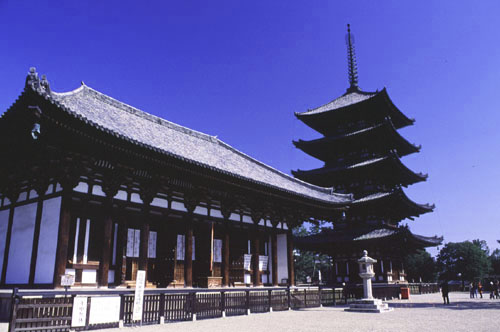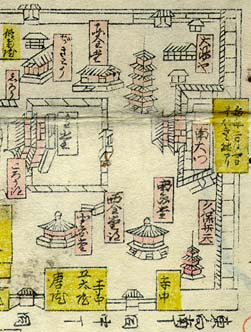Nara, the Southern Capital – Buddhist Monasteries
in the Medieval Times
In 784, the capital was moved from Heijô-Kyô
(Nara) to Nagaoka-Kyô. But after only 10 years, Heian-Kyô
(Kyoto) became the new capital in 794. One of the reasons for
this move was to reduce the influence of Buddhist priests on
the government. Therefore, Buddhist monasteries were prohibited
from establishing themselves in the new capital. Nara was desolate
for some time, but the monasteries gradually recovered their power
and continued to be influential during the medieval times. As
a result, Nara developed itself into a religious center. In those days,
Nara was also called "Nanto," which means Southern Capital,
while Kyoto was the capital in the north.
Kôfuku-ji: A Buddhist monastery originally established in
Yamashina (eastern suburbs of Kyoto), and re-established in Nara
in the 8th century.
(Right) Kôfuku-ji on a woodblock-printed map of the 19th
century.
Among the seven major Buddhist monasteries
in Nara, Kôfuku-ji (tutelary monastery of the powerful Fujiwara
family) and Tôdai-ji (built as the guardian of the country
and famous for its Great Statue of Buddha) increased their shôens (estates or manors) and
gained economic power. Moreover, from the 12th century on, many
powerful nobles entered the Buddhist priesthood, and so the centers
of Buddhism in Nara acquired political power to influence the
government in Kyoto. The major monasteries had their own troops
of sôhei (armed monks), which took part in military
operations. The bakufu (shogunate or warrior government)
in Kamakura (1185-1333) ruled the entire country through appointing
shugo (constable) for each province, but Kôfuku-ji
successfully prevented the bakufu from appointing shugo
for Yamato Province (modern Nara Prefecture) by insisting that
it was "the Divine Province." Accordingly, Kôfuku-ji
substantially ruled over the province as the feudal lord taking
charge of military and police affairs. In the course of these
developments, people within the province were organized into groups
of warriors. From the viewpoint of economic development, as the
monasteries became more and more wealthy, people in the trades
and crafts gathered around the monasteries to form urban settlements.
These settlements compose today's old town of Nara (Nara-machi).
Buddhist monasteries, especially Kôfuku-ji, played the leading
role in forming the medieval landscape
of the Nara region.
By Yuko Hiroshige, graduate student at the Graduate University
for Advanced Studies
Last updated: 15/May/2001

Back to the Index of Soramitsu



